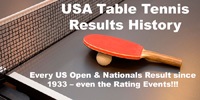Let me start by being absolutely clear – you should take all serious matches seriously. That may sound like circular reasoning, taking serious matches seriously, but they have slightly different meanings. “Serious matches” means, in this context, matches where the top priority is to win, i.e. tournament and league matches. (You should also try to win practice matches, but they are also just that – practice, where you both practice your shots and techniques, and practice finding ways to win.) But much of this depends on your opponent. And for this, I’m dividing them into three types. (Some top players or coaches will disagree with this and would say to treat all opponents at all levels the same. There’s no problem with that. Whatever works best for you.)
“Serious” opponents are those where the match is competitive, or the opponent is much stronger. You should throw whatever you have at them, tactically. I could write a whole book on this.
“Practice” opponents are those who can play, but are not threats to you. There’s no point in throwing every tricky serve you have at them once you’ve established that you can dominate nearly every point. Against players like this, once you’ve verified that the match isn’t competitive, you can turn them into practice matches – always with the provision that you can go back to pure winning tactics at any time.
For example, I might serve short backspin over and over against such a player, he’ll push it back, and I’ll start every rally by looping. Not only should I dominate this way, but I get great practice from it – which prepares me for the next match. (I could also fake backspin and serve no-spin, and he’d likely pop it up, giving me an easy put-away – but I wouldn’t get as much practice with that, would I? Stronger players will mostly keep the ball low, and will rarely pop the ball up like that.) PLUS – in that rare time where you do run into trouble, you can always fall back on what worked before, such as your trickier serves – and by not using them as much earlier, the opponent isn’t used to them, and so they are doubly effective. To use the USATT rating system, if I were 2300 and my opponent was, say, 1500, then once I’ve established that he really is 1500, and perhaps won the first game easily, I might play the rest of the way for practice. You can judge for yourself at what level a match might be competitive for you.
A key thing – and read this three times – is that you don’t let up mentally. You still play each point to win, you just don’t bother with your best serves or best tactics as long as you are dominating without them. If you let up mentally, that could cost you in the next match, and perhaps even in this match. Always remember that it’s easier to keep your focus then to recover it once lost.
An alternate version for some players is play the rest of the match perhaps just pushing and blocking, so as not to tire yourself out for the next match. I know of some older or out-of-shape players who do this. Another option is to use the match to practice your best serves. I’ve done both. You can also differentiate based on the event you are playing. If you are playing for a national or state title, you might treat each match differently than if it’s at a small, monthly event.
“Beginner” opponents are just that – beginners, or beginning-intermediate players. Some like to play for the 11-0 win; others give a mercy point. That’s up to you. I tend to throw a few good serves at them now and then so they can see them, but mostly just rally with them, and use the match to loosen up. If I am up 10-0, I’ll usually put one up a bit to their forehand and challenge them to hit one past me. Matches like this are actually good mental preparation – if you can keep your focus throughout the match, even while not playing fully serious, you can probably do so in your next, more competitive match.





